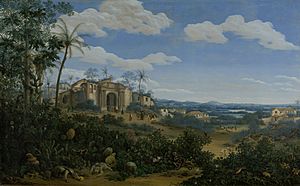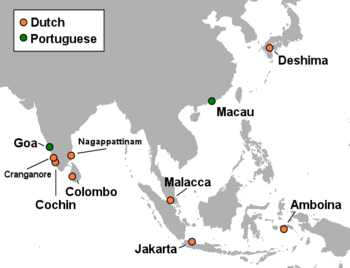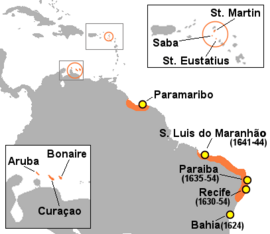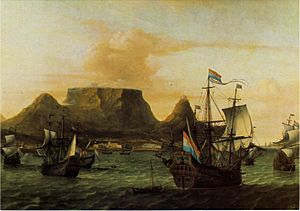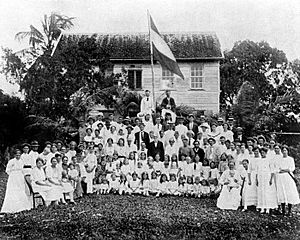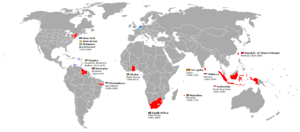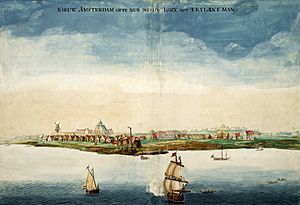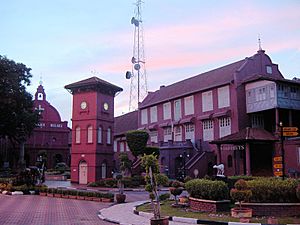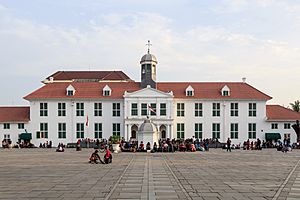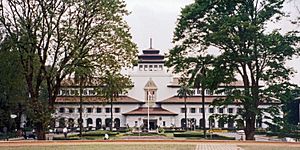Dutch colonial empire facts for kids
Quick facts for kids
Dutch colonial empire
Nederlandse koloniale rijk
|
|
|---|---|
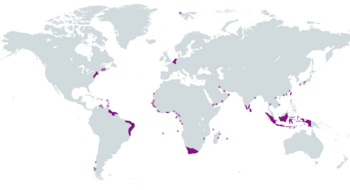
The Dutch colonial empire
|
The Dutch colonial empire was made up of lands and trading posts far away from the Netherlands. These places were first controlled by big Dutch trading companies. The most famous ones were the Dutch East India Company and the Dutch West India Company. Later, the Dutch Republic and then the modern Kingdom of the Netherlands took charge.
This empire was mostly about trade. The Dutch became powerful by controlling important shipping routes around the world. They set up trading posts in key locations. Unlike some other empires, the Dutch didn't always try to take over huge areas of land. They focused on buying and selling goods. The Dutch were among the first European countries to build an empire, after Spain and Portugal. They were also one of the richest nations at that time.
Most of the Dutch empire's lands were coastal forts, factories, and port towns. These places had different levels of control over the land around them. The Dutch trading companies wanted to keep their costs low. So, they often kept their territories small. Some places, like the Dutch Cape Colony and Dutch East Indies, grew bigger because Dutch settlers moved there. But others stayed as small trading centers. They depended on the local people for trade. This shows that the main goal of the Dutch empire was business, not ruling large landmasses.
The Dutch were already great at shipping. This helped them build their empire. They played a big part in growing sea trade between Europe and Asia. Small European trading companies often didn't have enough money or people for big operations. So, the Dutch government created larger organizations in the early 1600s. These were the Dutch West India Company and the Dutch East India Company. They were the biggest trading companies of their time. They had almost complete control over important shipping routes. These routes went west around South America through the Strait of Magellan. They also went east around Africa, past the Cape of Good Hope. The companies' control over global trade helped the Netherlands have a "Dutch Golden Age" in the 17th century. This was a time of great wealth and culture. Dutch sailors also explored new trade paths between Asia and Europe. They mapped places like Australia, New Zealand, Tasmania, and parts of North America. During this time, the empire got a lot of textiles and silks from India's Mughal Empire.
In the 1700s, the Dutch colonial empire started to shrink. This happened after the Fourth Anglo-Dutch War (1780–1784). The Dutch Republic lost some of its colonies and trade deals to the British Empire. The British also took over Mughal Bengal. But large parts of the Dutch empire lasted until after World War II. This is when many colonies around the world became independent. The main parts that remained were the Dutch East Indies and Dutch Guiana. Today, three former Dutch territories in the West Indies—Aruba, Curaçao, and Sint Maarten—are still part of the Kingdom of the Netherlands.
Contents
- Former Dutch Colonial Possessions
- History of the Dutch Empire
- How the Empire Began (1590s–1602)
- The Dutch East India Company (VOC) (1602–1609)
- Dutch Takeover of the Banda Islands (1609–1621)
- Conflicts with Spain and Portugal (until 1661)
- Dutch Colonization in Asia
- Dutch Colonization in the Americas
- Dutch Colonization in Southern Africa
- Rivalry with Great Britain and France (1652–1795)
- The Napoleonic Era (1795–1815)
- After Napoleon (1815–1945)
- Decolonization (1942–1975)
- Legacy of the Dutch Empire
- Territorial Evolution of the Dutch Empire
- See Also
Former Dutch Colonial Possessions
This list does not include some trading posts like Dejima in Japan.
- Dutch East Indies (1603–1949), and Dutch New Guinea (until 1962)
- Dutch India (1605–1825)
- Dutch Gold Coast (1612–1872)
- New Netherlands (1614–1667, 1673–1674)
- Dutch Guianas (1616–1975)
- Dutch Formosa (1624–1662), and Keelung (1663–1668)
- Dutch Virgin Islands (1625–1680)
- Dutch Bengal (1627–1825)
- Dutch Brazil (1630–1654)
- Dutch Mauritius (1638–1710)
- Dutch Ceylon (1640–1796)
- Dutch Malacca (1641–1795, 1818–1825)
- Dutch Cape Colony (1652–1806)
- Dutch Malabar (1665–1795)
- Dutch Surinam (1667–1954)
- New Holland (Acadia) (1674–1678)
History of the Dutch Empire
How the Empire Began (1590s–1602)
In the 1560s, a long war called the Eighty Years' War started in the Netherlands. Some rebel provinces joined together and declared independence from Spain. In 1588, they formed the Dutch Republic. This war lasted for eighty years and caused many deaths.
The war was fought mostly in Europe. But it also spread to Spain's overseas territories. This included Spanish colonies and Portuguese trading posts. At that time, Portugal was ruled by the King of Spain. The city of Lisbon in Portugal was the main European market for goods from India. Merchants from all over Europe came there to buy spices and other exotic items.
However, when Portugal joined with Spain in 1580, all Portuguese markets were closed to the Dutch. So, in 1595, the Dutch decided to sail to Asia themselves. They used secret maps of Portuguese trade routes.
The Dutch provinces of Holland and Zeeland had been important trade centers for centuries. Their location made it easy to trade with France, England, and other countries. In the 1580s, many traders moved from Antwerp (a big trading city) to Dutch cities like Amsterdam. Amsterdam became a major center for shipping, banking, and insurance. The Dutch used their wealth to expand their trade routes. By the 1590s, Dutch ships were trading with Brazil and the Dutch Gold Coast in Africa. They also sailed to the Indian Ocean to get valuable spices.
This put the Dutch in direct competition with Portugal. Portugal had controlled these trade routes for decades. They had set up colonies in Brazil, Africa, and the Indian Ocean. But the rivalry wasn't just about money. By attacking Portuguese lands, the Dutch forced Spain to spend money and soldiers defending them. This helped the Dutch in their fight for independence from Spain. This was the start of the Dutch–Portuguese War.
In the 1590s, "pioneer companies" were formed. They were told to focus on trade. They could only use violence if they had to defend themselves. In 1594, the "Company of Far Lands" was started in Amsterdam. It sent two fleets to the spice islands of Maluku. The first fleet returned in 1597 with pepper. It made enough money to cover the trip's costs. The second trip (1598–1599) made a huge profit for its investors. These successes led to many companies competing for the spice trade. This competition was bad for business. It made spice prices go up in Asia and down in Europe. Also, some Dutch ships started to attack Spanish and Portuguese ships to steal spices. This was seen as a way to fight against their enemies.
The Dutch East India Company (VOC) (1602–1609)
Because of the problems from too much competition, the Dutch East India Company (VOC) was created in 1602. The Dutch government gave the VOC special rights for 21 years. They had the only right to trade and sail east of the Cape of Good Hope and west of the Straits of Magellan. The leaders of the VOC could build forts, sign treaties, and even have their own army and navy. They could also fight defensive wars. The VOC was set up as a joint stock company. This meant many people could buy shares in it, just like the English East India Company.
Soon after the VOC started, a big event happened. In 1603, VOC ships captured a Portuguese ship called the Santa Catarina near Singapore. When the Dutch captain returned to Amsterdam with the stolen goods, it caused a big debate. People argued about whether it was legal or right to attack other ships. A lawyer named Hugo Grotius wrote a paper in 1604. He said that attacking enemy ships was allowed during wartime.
In 1603, the Dutch government also gave the VOC permission to "damage the enemies and inflict harm on their persons, ships and goods." This was a very important decision. It turned the VOC into a tool for war and expanding the empire in Asia. The VOC used this power against the Spanish and Portuguese. They also used it against local Asian rulers later on. The Dutch wanted to control sea trade in Southeast Asia. They sometimes did things that other countries saw as piracy.
During peace talks between 1608 and 1610, the Dutch tried to get important trading spots in Asia. The VOC quickly made many deals with local rulers. These deals were in places like the Malay Peninsula, Sumatra, the Banda Islands, the Moluccas, and southern India.
Dutch Takeover of the Banda Islands (1609–1621)
The Dutch wanted to control the spice trade, especially for nutmeg and mace. These spices only grew on the Banda Islands. The local people of Banda had traded with others for a long time. They did not want to trade only with the Dutch. The Dutch used force to make the Bandanese agree to their terms. This led to a long and brutal conflict.
In 1621, the Dutch governor, Jan Pieterszoon Coen, led a military campaign. The Dutch killed many Bandanese people and enslaved others. They took complete control of the islands. After this, the Dutch brought in slaves and workers from other places to grow nutmeg. This event was a dark chapter in Dutch colonial history. It showed how far the Dutch would go to control valuable trade.
Conflicts with Spain and Portugal (until 1661)
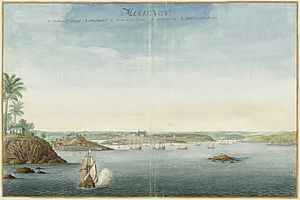
The Dutch attacked many of Portugal's trading posts around Asia. This included places like Ceylon (now Sri Lanka) and Goa. They also attacked Portuguese interests in Japan, Africa (like Mina), and South America. Even though the Portuguese never fully controlled Ceylon, they held its coastal areas for a long time before the Dutch arrived. Portugal's colony in Brazil was partly taken over by the Dutch.
In 1621, the Dutch West India Company (WIC) was formed. It was given a 25-year monopoly to trade in the Atlantic, the Americas, and the west coast of Africa. The Dutch also set up a trading post in Ayutthaya, Thailand, in 1604.
In the 17th century, the WIC had a "Grand Design." They wanted to control the international sugar trade. To do this, they attacked Portuguese colonies in Brazil and Africa. They aimed to seize both the sugar plantations and the slave ports needed for labor. Portugal was weaker because it was joined with Spain, and Spain was busy elsewhere. But the Portuguese still fought back.
After the Dutch captured the entire Spanish treasure fleet in 1628, the WIC had enough money for a big operation. In 1630, the Dutch took over the Portuguese sugar settlement of Pernambuco in Brazil. Over the next few years, they expanded inland, taking over sugar plantations. To get enough workers for these plantations, the Dutch captured the Portuguese slave trading post of Elmina in 1637. They also took Portuguese settlements in Angola in 1641. Both Brazil and Africa were used as bases for Dutch ships to attack Portuguese and Spanish trade routes.
However, the union between Spain and Portugal ended in 1640. This led to more resistance from Portuguese settlers in Brazil. The Dutch were finally defeated in the 1650s. But they received a large amount of money (63 tons of gold) in exchange for giving up their claims over Brazil in the 1661 Treaty of the Hague.
Dutch Colonization in Asia
The war between Spain and other countries weakened the Portuguese Empire. For example, England took Ormuz from Portugal in 1622. But the Dutch Empire gained the most from Portugal's decline.
The VOC immediately started taking over the coastal forts that made up the Portuguese Empire. These settlements were isolated and hard to defend. The Dutch had mixed success in capturing them. They took Amboina from the Portuguese in 1605. But an attack on Malacca the next year failed. The Dutch were looking for a better base in the East Indies. They found it in Jakarta, which Jan Pieterszoon Coen conquered in 1619. Jakarta was later renamed Batavia and became the capital of the Dutch East Indies.
Meanwhile, the Dutch continued to push the Portuguese out of their bases in Asia. Malacca finally fell in 1641. Colombo fell in 1656, Ceylon in 1658, Nagapattinam in 1662, and Cranganore and Cochin in 1662.
Goa, the main city of the Portuguese Empire in the East, was attacked by the Dutch in 1603 and 1610, but they failed to capture it. The Dutch also tried four times to take Macau, where Portugal controlled the valuable trade between China and Japan. They failed. However, the Japanese government became suspicious of the Catholic Portuguese. So, Japan expelled the Portuguese in 1639. Under Japan's strict "sakoku policy" (1639-1854), the Dutch were the only European power allowed to trade in Japan. They were confined to Hirado and then to Dejima from 1641. In the mid-17th century, the Dutch also explored the western Australian coasts, naming many places.
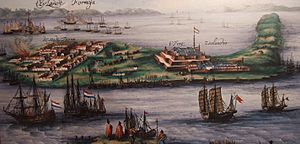
The Dutch colonized Mauritius in 1638. This was decades after three Dutch ships landed there by accident in 1598. They named the island after Prince Maurice of Nassau. The Dutch found the climate difficult and left the island after several decades.
The Dutch set up a colony at Tayouan (now Anping) in southern Taiwan. Taiwan was then mostly controlled by Portuguese traders and known as Formosa. In 1642, the Dutch took northern Formosa from the Spanish by force.
The Dutch tried to use military force to make Ming China open up to Dutch trade. But the Chinese defeated the Dutch in a war over the Penghu islands (1623-1624). This forced the VOC to leave Penghu for Taiwan. The Chinese defeated the Dutch again at the Battle of Liaoluo Bay in 1633.
In 1646, the Dutch tried to capture the Spanish colony in the Philippines. They had a large army, but they were defeated at the Battles of La Naval de Manila when they tried to take Manila. After this defeat, they stopped trying to capture Manila and the Philippines.
Between 1602 and 1796, the VOC sent almost a million Europeans to work in the Asia trade. Most died from disease or went back to Europe. But some made the Indies their new home. Dutch people and local populations mixed mostly in Sri Lanka and the Indonesian Islands. Over centuries, a large Dutch-speaking group of mixed Dutch and Indonesian descent grew. They are known as Indos or Dutch-Indonesians.
Dutch Colonization in the Americas
In the Atlantic, the West India Company (WIC) focused on taking control of the sugar and slave trade from Portugal. They also attacked Spanish treasure fleets returning home. Bahia on the northeast coast of Brazil was captured in 1624. But it was held for only a year before Spain and Portugal recaptured it. In 1628, Piet Heyn captured an entire Spanish treasure fleet. He took a huge amount of precious metals and goods. This allowed the WIC to pay its shareholders a 70% profit two years later. However, the company had few other big successes against the Spanish.
In 1630, the Dutch took over the Portuguese sugar settlement of Pernambuco. Over the next few years, they moved inland, taking over the sugar plantations around it. To get workers for the plantations, a successful mission was launched from Brazil. They captured the Portuguese slave trading post of Elmina in 1637. They also captured Portuguese settlements in Angola in 1641. In 1642, the Dutch took the Portuguese possession of Axim in Africa. By 1650, the WIC controlled both the sugar and slave trades. They had also taken Caribbean islands like Sint Maarten, Curaçao, Aruba, and Bonaire. This gave them access to the islands' salt-pans.
Unlike in Asia, the Dutch's successes against the Portuguese in Brazil and Africa did not last long. Years of settlement meant many Portuguese communities were under Dutch rule. The Dutch were traders, not colonizers. In 1645, the Portuguese in Pernambuco rebelled against the Dutch. By 1654, the Dutch were forced out of Brazil. In the years between, a Portuguese group from Brazil recaptured Luanda in Angola, expelling the Dutch by 1648.
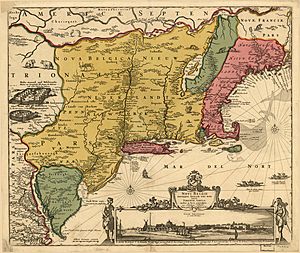
On the northeast coast of North America, the West India Company took over a settlement. It had been started by the New Netherland Company (1614–1618) at Fort Orange (now Albany) on the Hudson River. The Dutch had been sending ships to the Hudson River every year since Henry Hudson's voyage in 1609 to trade for fur. To protect their position at Albany from the English and French, the Company founded the fortified town of New Amsterdam in 1625. This was at the mouth of the Hudson. They encouraged people to settle in nearby areas like Long Island and New Jersey. The Company found it hard to control the fur trade because of a lot of illegal private trading. So, the settlement of New Netherland was not very profitable. In 1655, the nearby colony of New Sweden on the Delaware River was taken over by New Netherland. The Dutch governor, Pieter Stuyvesant, sent ships and soldiers to capture it.
From the start, the Dutch East India Company competed with the English East India Company. The English company was founded two years earlier but had much less money. They competed for the same goods and markets in the East. In 1619, this rivalry led to the Amboyna massacre. Several English company men were executed by Dutch agents. This event caused English anger for decades. It was even used as a reason for war during the Second Anglo-Dutch War in the 1660s. However, in the late 1620s, the English company shifted its focus from Indonesia to India.
In 1643, the Dutch West India Company established a settlement in the ruins of the Spanish settlement of Valdivia, in southern Chile. The goal was to get a foothold on the west coast of the Americas. This area was almost entirely controlled by Spain. The Dutch also wanted to get gold from nearby mines. But the local people were not cooperative. They had already forced the Spanish to leave Valdivia in 1604. This led the Dutch expedition to leave after a few months. This Dutch presence caused the Spanish to return to Valdivia and build one of the largest defensive systems in colonial America.
Dutch Colonization in Southern Africa
By the mid-17th century, the Dutch East India Company was the main player in the spice and silk trade. In 1652, they started a colony at the Cape of Good Hope on the southern African coast. This was a place for their ships to stop and get supplies on the way between Europe and Asia. More Dutch people moved to the Cape quickly. They were offered large pieces of land and no taxes if they produced food for passing ships. The Cape authorities also brought in Europeans from other countries, like Germans and French Huguenots. They also brought thousands of slaves from the East Indies to help with work. Over time, different groups mixed through marriage and everyone started speaking Dutch. Differences were more about social class and race.
The Dutch colony at the Cape of Good Hope grew beyond its first settlement. It officially became the Dutch Cape Colony in 1778. By this time, the Dutch had taken control of the local Khoisan and San peoples' lands. Dutch military trips further east stopped when they met the Xhosa people expanding westward. The Dutch government and the Xhosa leaders agreed to mark their borders and not cross into each other's land. However, the Dutch could not control their own settlers. These settlers ignored the agreement and went into Xhosa territory. This started one of Southern Africa's longest colonial conflicts: the Xhosa Wars.
Rivalry with Great Britain and France (1652–1795)
In 1651, the English parliament passed the first of the Navigation Acts. These laws stopped Dutch ships from trading between England and its Caribbean colonies. This directly led to war between the two countries the next year. This was the first of three Anglo-Dutch Wars that lasted on and off for two decades. These wars slowly weakened Dutch naval power and helped England.
In 1661, during the Qing conquest of China, a Ming general named Koxinga led a fleet to invade Formosa. The Dutch defense, led by governor Frederick Coyett, held out for nine months. But after Koxinga defeated Dutch reinforcements, Coyett surrendered Formosa. The Dutch never ruled Formosa again.
The Second Anglo-Dutch War started in 1664. English forces moved to capture New Netherland. Under the Treaty of Breda (1667), New Netherland was given to England. In return, the English gave up their settlements in Suriname, which the Dutch had conquered earlier that year. The Dutch did take New Netherland back in 1673 during the Third Anglo-Dutch War. But it was returned to England the next year. This ended Dutch rule in mainland North America. However, a large Dutch community remained under English rule. They kept their language, church, and customs until the mid-18th century.
In South America, the Dutch took Cayenne from the French in 1658. They also fought off a French attempt to retake it a year later. But it was given back to France in 1664 because the colony was not profitable. The Dutch recaptured it in 1676, but it was returned again a year later, this time for good. The Glorious Revolution of 1688 saw the Dutch William of Orange become King of England. This ended eighty years of rivalry between the Netherlands and England. But the rivalry with France stayed strong.
During the American Revolutionary War, Britain declared war on the Netherlands. This was the Fourth Anglo-Dutch War. Britain seized the Dutch colony of Ceylon. Under the Peace of Paris (1783), Ceylon was returned to the Netherlands. But Negapatnam was given to Britain.
The Napoleonic Era (1795–1815)
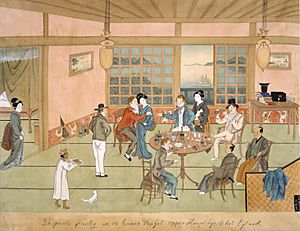
In 1795, the French Revolutionary Army invaded the Dutch Republic. They turned the country into a state controlled by France, called the Batavian Republic. Britain, which was at war with France, quickly moved to take over Dutch colonies in Asia, South Africa, and the Caribbean.
Under the Treaty of Amiens signed by Britain and France in 1802, the Cape Colony and the Dutch West Indies islands that the British had taken were returned to the Republic. Ceylon was not returned to the Dutch and became a British Crown Colony. When fighting between Britain and France started again in 1803, the British retook the Cape Colony. The British also invaded and captured the island of Java in 1811.
In 1806, Napoleon ended the Batavian Republic. He made his brother, Louis Bonaparte, king of the Netherlands. Louis was removed from power by Napoleon in 1810. The country was ruled directly by France until it was freed in 1813. The next year, the independent Netherlands signed the Anglo-Dutch Treaty of 1814 with Britain. All the colonies Britain had seized were returned to the Netherlands. The only exceptions were the Dutch Cape Colony, Dutch Ceylon, and part of Dutch Guyana.
After Napoleon (1815–1945)
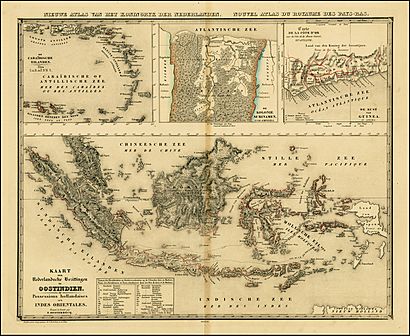
After Napoleon's defeat in 1815, Europe's borders were redrawn at the Congress of Vienna. For the first time since declaring independence from Spain in 1581, the Dutch were reunited with the southern Netherlands. They formed a constitutional monarchy called the United Kingdom of the Netherlands. This union lasted only 15 years. In 1830, a revolution in the southern half of the country led to the independence of the new state of Belgium.
The Dutch East India Company went bankrupt and was closed down on January 1, 1800. Its territories became national property, known as the Dutch East Indies. Rivalry between Britain and the Netherlands in Southeast Asia continued over the port of Singapore. Singapore had been given to the British East India Company in 1819 by the sultan of Johore. The Dutch claimed that a treaty signed earlier gave them control of the region. However, it became clear that the British could not be removed from Singapore, which was becoming a very important trade center. So, the disagreement was solved with the Anglo-Dutch Treaty of 1824. Under this treaty, the Netherlands gave Malacca and their bases in India to the British. They also recognized Britain's claim to Singapore. In return, the British handed over Bencoolen and agreed not to make treaties with rulers in the "islands south of the Straits of Singapore." This divided the archipelago into two areas of influence: a British one in the Malay Peninsula, and a Dutch one in the East Indies.
For most of its history, Dutch control over the East Indies was often weak. But it expanded during the 19th century. Only in the early 20th century did Dutch rule reach the borders of what is now Indonesia. Although Java was under Dutch control for most of the 350 years, many areas remained independent for much of this time. These included Aceh, Lombok, Bali, and Borneo.
In 1871, all Dutch possessions on the Dutch Gold Coast were sold to Britain. The Dutch West India Company was ended in 1791. Its colonies in Suriname and the Caribbean came under direct state rule. The economies of the Dutch Caribbean colonies had been based on smuggling goods and slaves into Spanish America. But with the end of the slave trade in 1814 and the independence of new nations in South and Central America, profits quickly dropped. Dutch traders moved from the islands to the United States or Latin America. This left small populations with little income, needing money from the Dutch government. The Antilles were combined with Suriname under one government from 1828 to 1845.
Slavery was not abolished in the Dutch Caribbean colonies until 1863. This was much later than in Britain and France. By this time, only 6,500 slaves remained. In Suriname, slave owners demanded money from the Dutch government for freeing slaves. In Sint Maarten, slavery was abolished in the French part in 1848. This led slaves in the Dutch part to gain their own freedom. In Suriname, after slavery ended, Chinese workers were encouraged to come as indentured laborers. Javanese workers also came between 1890 and 1939.
Decolonization (1942–1975)
Indonesia's Independence
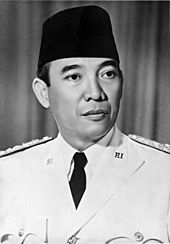
In January 1942, Japan invaded the Netherlands East Indies. The Dutch surrendered two months later in Java. Indonesians first welcomed the Japanese as liberators. The Japanese occupation of the Dutch East Indies during World War II completely broke down the Dutch colonial system. It was replaced by a Japanese government. Before the war, the Dutch had mostly stopped the small independence movement in Indonesia. So, the Japanese occupation was very important for Indonesian independence.
Two days after Japan surrendered in August 1945, Sukarno and another leader, Hatta, declared Indonesian independence. A four-and-a-half-year struggle followed as the Dutch tried to get their colony back. Dutch forces eventually re-occupied most of the territory. But a guerrilla war continued. Most Indonesians, and eventually international opinion, wanted independence. In December 1949, the Netherlands officially recognized Indonesian sovereignty.
Under the 1949 agreement, Western New Guinea remained under Dutch control as Netherlands New Guinea. Its future was to be decided later. The new Indonesian government, led by President Sukarno, pushed for the territory to become part of Indonesia. After pressure from the United States, the Netherlands transferred it to Indonesia under the 1962 New York Agreement.
Suriname and the Netherlands Antilles
In 1954, the Netherlands, Suriname, and the Netherlands Antilles (which included Aruba at the time) became a combined state. It was called the "Tripartite Kingdom of the Netherlands." The former colonies were given self-rule. But the Kingdom was still in charge of things like defense, foreign affairs, and citizenship. In 1969, unrest in Curaçao led to Dutch marines being sent to stop rioting. In 1973, talks for independence began in Suriname. Full independence was granted in 1975. About 60,000 people moved to the Netherlands at that time. In 1986, Aruba was allowed to separate from the Netherlands Antilles federation. The Netherlands wanted Aruba to become fully independent within ten years. However, in 1994, it was agreed that Aruba could remain a separate country within the Kingdom.
On October 10, 2010, the Netherlands Antilles were dissolved. On that date, Curaçao and Sint Maarten became countries within the Kingdom, just like Aruba. The islands of Bonaire, Sint Eustatius, and Saba were given a status similar to Dutch municipalities. They are now sometimes called the Caribbean Netherlands.
Legacy of the Dutch Empire
Generally, the Dutch don't celebrate their imperial past much. Ideas against colonialism have been strong since a book by Jacob Haafner in 1807. Because of this, colonial history is not a big part of Dutch schoolbooks. This view of their empire has only recently started to change.
Dutch People Around the World
In some former Dutch colonies, there are large groups of people with Dutch ancestors. These are descendants of Dutch settlers who moved there. In South Africa, the Boers and Cape Dutch are known as Afrikaners. The Burgher people of Sri Lanka and the Indo people of Indonesia are mixed-race people with Dutch heritage. The Creoles of Suriname also have Dutch roots.
In the U.S., three presidents have had Dutch ancestors. Martin Van Buren was the first president not of British descent. His first language was Dutch. The 26th president, Theodore Roosevelt, and the 32nd president, Franklin D. Roosevelt, were also of Dutch descent. Franklin D. Roosevelt was the only U.S. president to serve more than two terms.
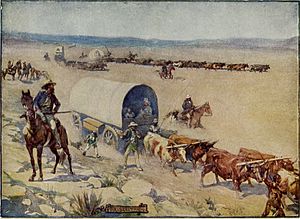

Dutch Language's Influence
Dutch in Southeast Asia
The Dutch were in Indonesia for almost 350 years. But the Dutch language has no official status there today. Only a small number of older, educated people, or those in legal jobs, can speak it well. This is because some legal codes are still only in Dutch. The Indonesian language borrowed many words from Dutch. These include words for everyday life, science, and technology. One expert says that 20% of Indonesian words come from Dutch.
Dutch in South Asia
The 150 years of Dutch rule in Ceylon (now Sri Lanka) and southern India left almost no traces of the Dutch language.
Dutch in the Americas
In Suriname, Dutch is the official language. About 82% of the people can speak Dutch fluently. In Aruba, Bonaire, and Curaçao, Dutch is also an official language. But it is the first language for only 7–8% of the population. Most people there are fluent in Dutch, and it is usually the language used in schools.
The people of the three northern Antilles—Sint Maarten, Saba, and Sint Eustatius—mostly speak English.
In New Jersey, an old form of Dutch called Jersey Dutch was spoken. It was used by descendants of 17th-century Dutch settlers. It was still spoken as late as 1921. U.S. President Martin Van Buren grew up in a Dutch-speaking area in New York. Dutch was his first language.
Dutch in Africa
The biggest language legacy of the Netherlands is in its former colony in South Africa. Many Dutch farmers (called Boer) settled there. They spoke a simpler form of Dutch called Afrikaans. Afrikaans is very similar to Dutch. After the colony became British, the settlers moved inland, taking their language with them. As of 2005, about 10 million people speak Afrikaans as a main or second language. This compares to over 22 million speakers of Dutch.
Other creole languages with Dutch roots include Papiamento. It is still spoken in Aruba, Bonaire, Curaçao, and Sint Eustatius. Saramaccan and Sranan Tongo are still spoken in Suriname. Berbice was an extinct language in Guyana. Pecok is spoken in Indonesia and the Netherlands, but it is in danger of disappearing. Albany Dutch is also spoken in the U.S. but is in danger of disappearing.
Extinct Dutch-based creole languages include: Skepi (Guyana); Negerhollands (also called "Negro Dutch"), Jersey Dutch and Mohawk Dutch (U.S.), and Javindo (Java).
Place Names from Dutch
Some towns in New York and areas of New York City were once part of the colony of New Netherland. They have Dutch names. Examples include Brooklyn (from Breukelen), Flushing (from Vlissingen), the Bowery (from Bouwerij, meaning construction site), Harlem (from Haarlem), Coney Island (from Conyne Eylandt, meaning Rabbit island), and Staten Island (meaning "Island of the States"). The last Dutch governor of New Netherland, Pieter Stuyvesant, has a street, a neighborhood, and schools named after him in New York City. Many towns along the Hudson River in upstate New York also have Dutch names. For example, Yonkers, Hoboken, Catskill, and Kinderhook. Nassau County on Long Island also has a Dutch origin. The Schuylkill River in Philadelphia has a Dutch name meaning "hidden river."
Many towns in Suriname share names with cities in the Netherlands. Examples are Alkmaar and Groningen. The capital of Curaçao is named Willemstad. The capitals of Saint Eustatius and Aruba are both named Oranjestad. Willemstad is named after the Dutch Prince Willem II van Oranje-Nassau. The other two are named after the first part of the current Dutch royal family's name.
Many of South Africa's major cities have Dutch names. These include Johannesburg, Kaapstad (Cape Town), Vereeniging, Bloemfontein, and Vanderbijlpark.
The country name New Zealand came from Dutch cartographers. They called the islands Nova Zeelandia, after the Dutch province of Zeeland. British explorer James Cook later changed the name to New Zealand.
The Australian island state Tasmania is named after Dutch explorer Abel Tasman. He was the first European to report seeing the island on November 24, 1642. He first named it Anthony van Diemen's Land, after his sponsor Anthony van Diemen, who was the Governor of the Dutch East Indies. The British later shortened the name to Van Diemen's Land. It was officially renamed in honor of its first European discoverer on January 1, 1856. Arnhem Land is named after the Dutch ship named Arnhem. The captain of the Arnhem also named the large island east of Arnhem Groote Eylandt, which means "Large Island" in modern Dutch.
Architecture from the Dutch Era
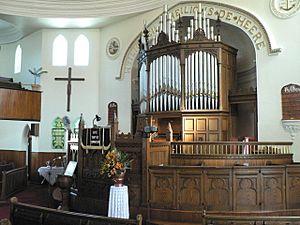
In the Surinamese capital of Paramaribo, the Dutch Fort Zeelandia still stands today. The city itself has kept most of its old street layout and buildings. It is now a UNESCO World Heritage site. In the center of Malacca, Malaysia, the Stadthuys Building and Christ Church are still there. They remind people of the Dutch time. There are also archaeological remains of Fort Goede Hoop (modern Hartford, Connecticut) and Fort Orange (modern Albany, New York).
Dutch architecture is easy to see in Aruba, Curaçao, Bonaire, and Saint Eustatius. The Dutch-style buildings are especially clear in Willemstad. They have steep gables, large windows, and tall decorations.
Dutch architecture can also be found in Sri Lanka. Especially in Galle, the Dutch fort and canal are still intact. Even some of the old tropical villas of the VOC officials remain. Some famous examples are the former governor's mansion in Galle, now the Amangalla Hotel, and the Old Dutch Reformed Church. In the capital Colombo, many Dutch and Portuguese buildings around The Fort were torn down by the British. But a few remain, like the Old Colombo Dutch Hospital and Wolvendaal Church.
During Dutch colonization in South Africa, a unique style of architecture developed. It is known as Cape Dutch architecture. These buildings can be found in historic towns like Stellenbosch, Swellendam, Tulbagh, and Graaff-Reinet. In the former Dutch capital of Cape Town, almost nothing from the VOC era has survived except the Castle of Good Hope.
The Dutch started building in Batavia soon after they arrived. But most Dutch-built structures still standing in Indonesia today are from the 19th and 20th centuries. Forts from the colonial era, used for defense, still stand in many major coastal cities. The largest number of surviving Dutch buildings are on Java and Sumatra. Especially in cities like Jakarta, Bandung, Semarang, Yogyakarta, Surabaya, Cirebon, Pasuruan, Bukittinggi, Sawahlunto, Medan, Padang, and Malang. There are also important examples of 17th-19th century Dutch architecture around Banda Neira, Nusa Laut, and Saparua. These were the main spice islands. Because there was limited economic development, they kept many of their colonial buildings. Another famous example is Fort Rotterdam in Makassar.
Early Dutch buildings often copied styles from the Netherlands. But these buildings were not good for the tropical climate and were expensive to keep up. So, Dutch officials started to adapt to the tropical conditions. They added local features like wide-open verandas, good ventilation, and high, sloped roofs to their villas. This style was called arsitektur Indis (Indies architecture). It combined traditional Hindu-Javanese styles with European forms.
Many public buildings still standing and used in Jakarta were built in the 19th century in the classicist style. These include the presidential palace and the finance ministry. At the start of the 20th century, more Dutch people moved to the colony as the economy grew. More middle-class people led to the development of garden suburbs in major cities. Many houses were built in different styles, from Indies style to modern Art Deco. Examples of these areas include Menteng in Jakarta and Darmo in Surabaya. Indonesia also became a place for Dutch Art Deco architecture experiments. Famous architects tried to modernize local architecture. This resulted in unique designs like Pohsarang Church and Bandung Institute of Technology. The most Art Deco buildings can be found in Bandung, which looks like the most European city in Indonesia.
Since Indonesia became independent, few governments have been interested in saving historical buildings. Many grand buildings have been torn down to build shopping centers or offices. However, more Indonesians are now realizing the value of preserving their old buildings.
Infrastructure
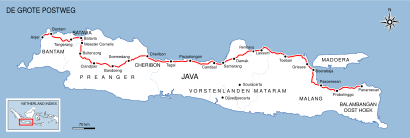
Besides Indonesia's Art Deco buildings, much of the country's rail and road systems were built during the colonial period. Many of Indonesia's main cities were just small towns before Dutch industrial and urban development. Examples on Java include the capital Jakarta and Bandung. Outside Java, examples include Ambon and Menado city. Most main railroads and train stations on Java were built during the Dutch East Indies era. The main road, called Daendels Great Post Road, connecting west to east Java, was also built then.
Between 1800 and 1950, Dutch engineers created a lot of infrastructure. This included 67,000 kilometers (41,600 miles) of roads and 7,500 kilometers (4,660 miles) of railways. They also built many large bridges and modern irrigation systems for 1.4 million hectares (5,400 sq mi) of rice fields. Several international harbors and 140 public drinking water systems were also built. These Dutch-built public works became the foundation for the colonial and later independent Indonesian state.
Agriculture
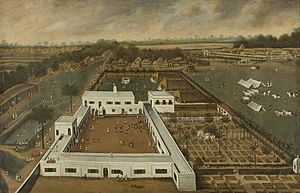
Crops like coffee, tea, cocoa, tobacco, and rubber were all brought in by the Dutch. The Dutch were the first to spread coffee plants in Central and South America. By the early 19th century, Java was the third largest coffee producer in the world. In 1778, the Dutch brought cacao from the Philippines to Indonesia and started growing it in large amounts. Today, Indonesia is the world's second largest producer of natural rubber. This crop was introduced by the Dutch in the early 20th century. Tobacco was brought from the Americas. In 1863, the first plantation was set up by the Dutch. Today, Indonesia is not only the oldest industrial producer of tobacco but also the second largest consumer of tobacco.
Scientific Discoveries
Java Man was discovered by Eugène Dubois in Indonesia in 1891. The Komodo dragon was first described by Peter Ouwens in Indonesia in 1912. This happened after an airplane crash in 1911 and rumors about living dinosaurs on Komodo Island in 1910.
Sports and the Dutch Legacy
Suriname
Many football players born in Suriname or of Surinamese descent have played for the Dutch national team. Famous examples include Ruud Gullit, Frank Rijkaard, Edgar Davids, Clarence Seedorf, and Virgil van Dijk. In 1999, Humphrey Mijnals, who played for both Suriname and the Netherlands, was named Surinamese footballer of the century.
Suriname usually does not allow dual citizenship. This means Surinamese-Dutch players who get a Dutch passport cannot play for the Surinamese national team. A Dutch passport helps them play in European leagues. In 2014, the Surinamese Football Association proposed allowing dual citizenship for athletes. This was to help their team qualify for the 2018 FIFA World Cup. A team of professional players of Surinamese origin was put together for an exhibition match. In 2019, it was announced that a "sports passport" would allow Dutch professional footballers of Surinamese origin to play for Suriname.
Suriname also has a national korfball team. Korfball is a Dutch sport. Vinkensport is also practiced in Suriname, as are popular Dutch sports like volleyball and troefcall.
South Africa
Ajax Cape Town was a professional football team. It was named and owned by Ajax Amsterdam, a Dutch club. It used their crest and colors.
The Dutch sport of korfball is managed by the South African Korfball Federation. They oversee the South Africa national korfball team. The 2019 IKF World Korfball Championship was held in August 2019 in Durban, South Africa.
Indonesia
The Indonesian football league started around 1930 during the Dutch colonial era. The Indonesian men's team was the first Asian team to qualify for the FIFA World Cup. In the 1938 FIFA World Cup, they played as the Dutch East Indies. Association football is now the most popular sport in Indonesia. It is played at all levels, from children to adults.
The Indonesian Tennis Association was founded during Dutch rule in 1935. It has a long history of national teams, though their first international games were after independence.
Like in the Netherlands, volleyball is still a popular sport. The Indonesian Volleyball Federation organizes both men's and women's professional leagues. It also manages the national teams.
The Dutch sport of korfball is also played, and there is a national korfball team.
Territorial Evolution of the Dutch Empire
See Also
 In Spanish: Imperio neerlandés para niños
In Spanish: Imperio neerlandés para niños
- Dutch colonization of the Americas
- Dutch Language Union
- List of Dutch East India Company trading posts
- Ministry of the Colonies (Netherlands)





